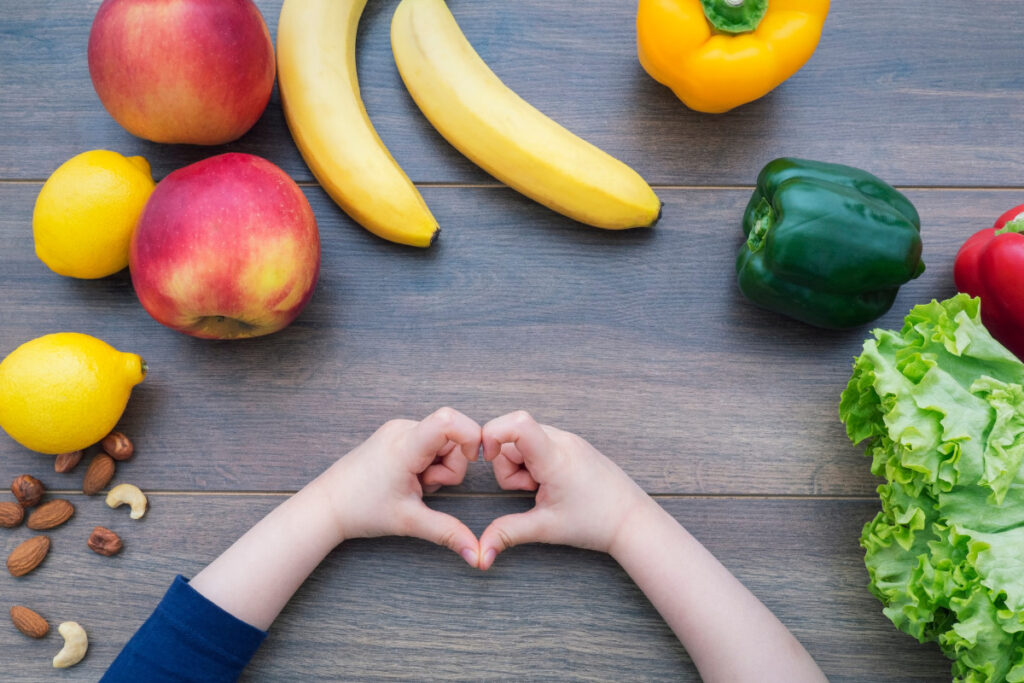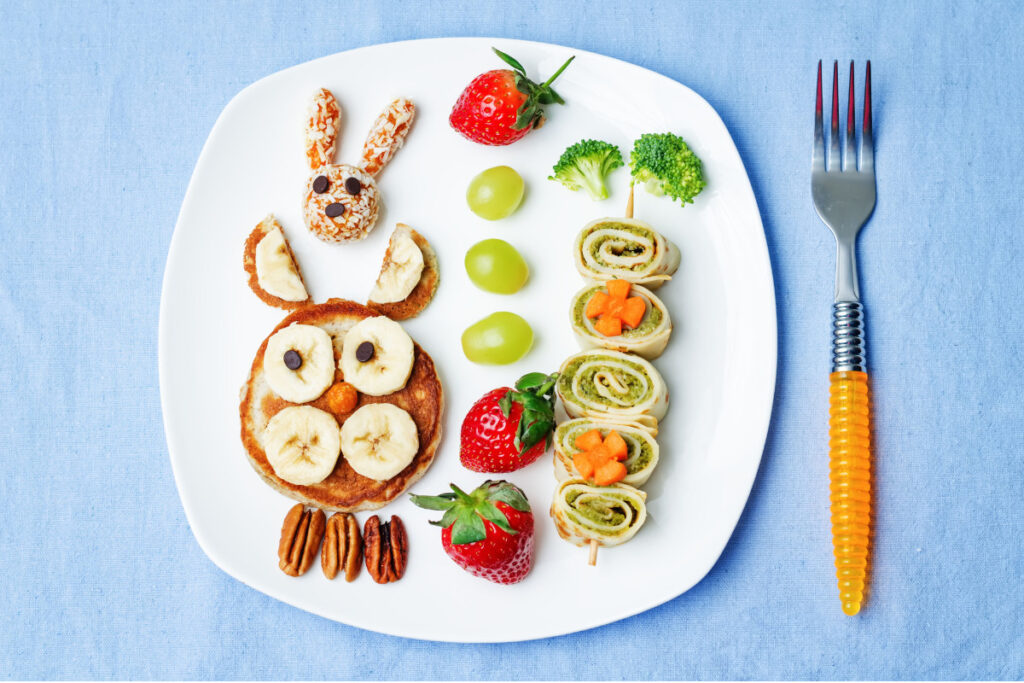As a parent or caregiver, the health of your child is in your hands. And when your kiddos are asking for snacks multiple times a day, it can be a challenge to know what to do. Do kids need snacks at all?
How do I get my kiddos to eat healthier snacks, not just the sugary, processed snacks they keep asking about? This is a really common struggle – if this sounds like your house, please know that you’re not alone.
One of the best ways to help children develop healthy habits and healthy bodies is to provide healthy food for them when they are young.
In this blog post, we will discuss 5 ways that you can improve your child’s snacking habits so that they get the nutrition they need while still enjoying the snacks that you’re offering!
To learn more about choosing healthy foods for kids, check out my free gut health e-book.
Do kids need snacks?
Yes!
Children need snacks in order to maintain healthy energy levels and to get the nutrients their growing bodies need. In general, I recommend that you offer your younger children three meals and three snacks daily. As kids get older, 1-2 snacks per day may be enough.
However, not all snacks are created equal. Many snacks that kids love or even that seem healthy, aren’t offering quite as much nutrition as you’d guess.
Many unhealthy snacks are high in added sugar and other nutrients that are not nourishing your child’s best health. That’s why it is important for parents to cultivate healthy habits, even at snack time.

What does “healthy” snacks mean?
There are many healthy snacks for kids that you can feed your child, but it’s important to know what healthy means. Healthy snacks can mean different things. I prefer that you focus on snacks that are low in added sugar and rich in vitamins, minerals, and fiber, most of the time.
It is also important to cultivate these healthy snacking habits now so that the habits can continue into adulthood.
With these five tips, you’ll have no problem teaching your child healthier snacking habits!
Tip 1: Pair Two Foods
For optimal nutrition and satisfaction, I recommend that you offer different foods groups when giving your kiddos snacks. Not only does this give you the opportunity to make a more satisfying snack, but it also gives your child more variety throughout the day.
Some healthy food pairings are:
- Freeze-dried strawberries and dry cereal
- Crunchy chickpeas
- Carrots and tortilla chips dipped in guacamole
- Celery or apples with nut butter
- Greek yogurt, nuts and berries
- Crackers or veggies with hummus
Offering more than one food item is also helpful for gently exposing picky eaters to different foods that might be out of their comfort zone for now. Keep the pressure off (no forcing a bite) and just make the experience fun.
And if your children are usually having processed and packaged snacks that you’d like to get away from, offer the new foods with the packaged snack instead of just taking the packaged snack away.
Tip 2: Vary presentation
It takes anyone a while to get used to something that feels new. And for kids – especially our picky eaters – new can mean scary and uncomfortable!
Think about carrots. Baby carrots are one way to offer carrots to your kiddos as a snack, but there are other options, too!
You can also offer carrots as a pureed pouch with carrots in the mix, shredded carrots for a different texture, roasted carrots for a different flavor, and even peels of a large carrot (feel free to call them ribbons!).
Each time your child has a chance to get to know the food in a low-pressure environment, it helps to build their confidence and eventually try it (and maybe even like it!).

Tip 3: Keep the portions small
If you’re working on new foods, snack time is a great opportunity because if they don’t eat much (or any) of the new food, dinner is right around the corner. By the time dinner is here, everyone tends to be more tired and less patient, so it can feel more difficult to make progress at that time.
When offering new foods at snack time, keep the portions of the new food small. For your child, it makes the experience less overwhelming.
And if age-appropriate, use toothpicks or other fun tools to serve the food. This keeps the experience more fun and playful for our kids, especially kids who can get overloaded with too much sensory information. You could try serving in muffin cups or placing the food on skewers.
Tip 4: Compare difference in healthy snacks
You know what’s fun and lower pressure? Exploring!
Instead of forcing your child to “just take a bite,” make the new food feel fun. This is lower pressure and more fun for everyone, not just your kiddo.
Try buying a few different varieties of a new food next time you’re at the grocery store. For example, four or five different kinds of apples. And during an afternoon when you have some free time, ask your child to describe how the apples are different in terms of size, color, and smell.
Which one smells the best?
Next: cut very tiny slices of each type of apple and invite your child to try them. Which apple is the sweetest? Most sour? Crunchiest?
Have fun ranking and exploring: this is way more fun than commanding your child to try a bite!
Tip 5: Involve your child
The more that you’re able to offer your child the opportunity to be involved, the better. For example, if you’re shopping for healthy snacks at the grocery store, ask your child which two healthy snacks they want to try this week.
Next: You can also offer choices when it comes to how foods are prepared. For example, would your child like their apple sliced or diced? Would they like to eat it with a dip, like a nut butter?
Try out a sneaky veggie with green pea hummus paired with your child’s favorite chips or veggies!
Kids can do far more tasks in the kitchen than most parents would guess. Will it be slower and messier to get them involved? At first: yes! But with time, their skills will grow (and the mess will slowly diminish).
Your child is going to be more open-minded about foods that they’ve helped to prepare.

Favorite healthy snack recipes
- Fruit Kabobs: Skewer pieces of colorful fruits like strawberries, grapes, melon, and pineapple on wooden sticks. The vibrant colors and variety make it a fun and tasty snack.
- Homemade Trail Mix: Mix together nuts (like almonds, walnuts), seeds (like pumpkin seeds), dried fruits (like raisins, cranberries), and a few dark chocolate chips for a balanced and satisfying snack.
- Greek Yogurt Parfait: Layer Greek yogurt with fresh berries, a drizzle of honey, and a sprinkle of granola. Kids can even help assemble their own parfaits.
- Veggie Dippers with Hummus: Cut colorful veggies like carrots, cucumber, bell peppers, and cherry tomatoes into sticks or rounds. Pair them with a side of hummus for a nutritious and tasty snack.
- Apple “Cookies”: Slice apples into rounds, spread a thin layer of nut butter, and sprinkle with toppings like chopped nuts, seeds, and a few mini chocolate chips.
- Frozen Banana Pops: Insert popsicle sticks into banana halves, dip them in melted dark chocolate, and roll them in chopped nuts or coconut flakes. Freeze until the chocolate hardens.
- Cucumber Sandwiches: Slice cucumbers into rounds and sandwich them with cream cheese or hummus. Add a thin slice of turkey or chicken for extra protein.
- Oatmeal Energy Bites: Mix oats, nut butter, honey, mini chocolate chips, and a dash of vanilla extract. Roll into bite-sized balls and refrigerate until firm.
Remember to involve kids in the preparation process as much as possible. Let them choose their favorite fruits, veggies, and toppings, and have fun making these snacks together!
To sum it up…
Being a parent in an environment with so many snack options can be very difficult. By partnering with a registered dietitian, you will learn how to conquer snack time with proven strategies to reach your health goals that will nourish your family’s health…even at snack time! I can’t wait to show you how!
I hope you’re feeling inspired to make positive changes in your family’s nutrition journey. With the right guidance and support, you can transform your kitchen into a hub of health and happiness. Let’s work together to craft a personalized nutrition plan that fits seamlessly into your lifestyle and brings smiles to your table. Reach out today to take the first step towards creating a healthier, happier future for your family. BOOK NOW!

References
Shield, Jo Ann. Kids Eat Right (2019, March 4). When Should My Kids Snack?
https://www.eatright.org/food/nutrition/dietary-guidelines-and-myplate/when-should-my-kids-snack